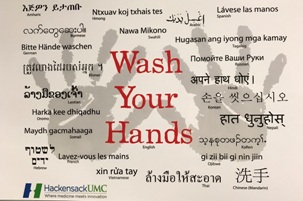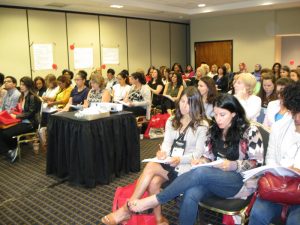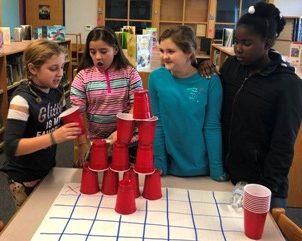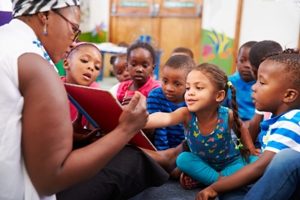NJ Teachers of English to Speakers of Other Languages/
NJ Bilingual Educators
ARTICLES
Roselyn Rauch and Marilyn Pongracz- A New Look: Keeping up with Technology
From the Editor: Roselyn Rauch- A Poster for Thought
President: JoAnne Negrin- Biliteracy Expert Cheryl Urow to Speak at Conference
Vice President: Caia Schlessinger- Highlights of the Spring Conference
Liaison for the Spring Conference: Tina Kern- Is Academic Language Important for our ELLs (including SLIFES)
Representative-at-Large/Liaison to Chapters and NJEA: Joyce Farr- Allaying…Fears and Sadness
Guest Contributor: Katherine Ware- Teaching Technology to English Language Learners
Guest Contributor: Hansel A. Perez- SIFE Success in Three Years
Guest Contributors: Dana Tinajero, LaDawna Harrington, and Rachael Harrington- Our Story: ELL, Storytelling, and the Library

A New Look – Keeping up with Technology
By Roselyn Rauch and Marilyn Pongracz
As you read this edition of Voices, you will notice our new look. Marilyn Pongracz, our Technology Coordinator, and I are moving Voices forward to make it more user-friendly. We realized that many read the issue on their cell phones so that now we have a platform that supports smart-phone technology in addition to your other media.
Technology changes so quickly that it requires constant updating. This new platform automatically does that for us. Along with the new platform, we are also trying a new layout, which we hope will improve your reading experience.
 From the Editor:
From the Editor:
A Poster for Thought
By Roselyn Rauch
Back in January, a family member needed to have a minor procedure at Hackensack University Medical Center. We were there for 7 hours from start to finish, and, yes, it truly was minor. (They are quite fine, thank you.) It should be no surprise that I needed to use the restroom. So, during that first trip to the loo, the Wash Your Hands sign, in multiple languages, posted over the towel dispenser, amused me. Cute.
I returned to the waiting area and continued to think about that sign; I knew that I had to have a photo of it. As time passed, and my brain whirled in TESOL mode, several thoughts occurred to me. With a few more trips, (TMI, Too Much Information?), this article formed in my ever-running mind.
If most of the languages represented on the Wash Your Hands poster were clients of the hospital, they most undoubtedly (a no-brainer) had children somewhere in their families. Children who are our students in New Jersey classrooms.
I would venture an educated guess, as I have no statistics to offer, that the majority of ESL (English as a Second Language) teachers have English as their native tongue, their L1. Now I do know there are New Jersey ESL teachers whose L1 is Spanish, Bengali, Arabic, Urdu, Italian, and Portuguese, and their L2 or L3 is English. I am not sure about Japanese and Korean ESL teachers. I would venture another educated guess, and I realize that I may very well be wrong, that we have very few, if any, ESL teachers whose L1 is Hmong, Tagalog, Vietnamese, or any of the other languages represented in small numbers in our classrooms. This leads to the realization that we are entrusted with the education of children/adults of so many languages and cultures. It is our job to teach them English and to bring to them a functioning familiarity of American culture. No easy feat. Yet, we do; we practice some magic every day, finding a way to communicate with our students for whom we have no common tongue. We dig deep into our bags of tricks and our teaching repertoires, to bring success, on so many levels, to our charges.
It is very hard work and we work at it every day, even thinking about strategies and methodologies when we are not even on the clock. Our students are always on the back burners of our minds; thoughts pop up at any given time. You deserve kudos and so much more for your dedication and determination.
So, now every time that you wash your hands, think about that magic that you do and that many others cannot begin to fathom, smile, and give yourself that big pat on the back.
Just as I had thought that I had finished my editorial piece, the United States mail arrived. Included among the many solicitations, magazines, and junk mail was my New Jersey Horizon Blue Cross/Blue Shield Insurance statement. Among the many papers in the stuffed envelope was the “If you need help understanding…..this bill”, a page of phone numbers for the bill’s translation in sixteen languages, some of which are mentioned above. The language translation services included Armenian, Farsi, German, Haitian Creole, Polish, and Russian. This just reinforces my point of the magic that we perform, especially when the ESL class is populated by a combination of these language-speakers. Give yourselves a huge pat on the back; you perform miracles, not magic.
In this Spring Edition of Voices, start by reading from the Features and SIGs (Special Interest Groups) from the main pages, side, or drop-down menus; use them as your personal GPS as you navigate through the articles. Read the various submissions in Features and SIGs (Special Interest Groups) to see what others have to offer to you to enhance that magic bag of tricks. There is always something in each piece from which everyone can benefit.
Be sure to register for our Spring Conference, the grandest opportunity to learn and share with your peers and hear from the renowned experts.
We do welcome guest contributors. Just be sure to read the newly revised Submission Guidelines, please.
Lastly, enjoy our new look.
Roselyn Rauch, Ed. D, is the editor of Voices and a retired ESL/ESL Resource Teacher for the Paterson Public School District. She is a consultant with ESL Unlimited.
President’s Message: 
Biliteracy Expert Cheryl Urow to Speak at Conference
By JoAnne Negrin, President
On February 28, Special Education Special Interest Group (SIG) Representative Sonya Bertini and I had a travel adventure on the way to the NABE (National Association of Bilingual Educators) conference that included storms, lots of turbulence, a diverted flight, missed connections, and a night spent in the baggage claim at the Dallas-Fort Worth airport. We were able to get on the first flight out in the morning to Albuquerque, but the plane touched down at 7:50 in the morning, and our presentation was supposed to be on at 8:30 a.m. Despite valiant efforts, we did not make it in time for our presentation slot. Fortunately, we weren’t the only ones with travel trouble, and they were able to allow us to present later that day. It was the kind of experience I’m sure we will look back on and laugh one day, but that day has not yet arrived.
We were there to deliver a presentation on a professional development initiative that we have been working on for the past year in my district. Ensuring uniform delivery of professional development across fifteen schools at 3 grade levels is always a challenge. That challenge is compounded by the fact that we only have one day during which we can get together as a K-12 department. So what do you do when you’ve got an important initiative to roll out and you want it to be job-embedded and sustained?
We have found the answer by taking it to the cloud. We have created a book study using Google Classroom focusing on Karen Beeman and Cheryl Urow’s Teaching for Biliteracy. There is a separate module for each chapter, and teachers get professional development credit for each module that they complete. It has been very exciting to see the substantive conversations that have taken place across grade levels and schools. People are engaged and talking with colleagues about things that matter about which they otherwise would not get to interact. Their insights have also given me important feedback as a district leader in terms of how we can continue to improve. Our presentation includes both the administrator’s perspective on this type of professional development experience, as well as the perspective of the teacher receiving the professional development.
Ms. Bertini and I will be presenting on this initiative on Friday, June 1, at the NJTESOL/NJBE Spring Conference. Cheryl Urow, co-author of Teaching for Biliteracy, will be the keynote speaker on that date and will host a breakout session. Kevin Vega, middle school teacher at Wallace Intermediate School in Vineland, NJ, will be presenting on his experience as a classroom teacher adopting a formal approach to biliteracy in his classroom as well. I think that these are timely topics, as more and more districts are implementing native language instruction and otherwise looking for other ways to strengthen students’ academic performance by leveraging their first languages.
This year’s Spring Conference is not to be missed for so many reasons. I hope to see you there.
JoAnne Negrin, President, NJTESOL/NJBE, jnegrin@njtesol-njbe.org
 Vice President
Vice President
Highlights of the Spring Conference
By Caia Schlessinger
On March 15th I was sitting at home with my family watching what was hopefully the last of the snow melting in our backyard. Now, it’s hard to believe that before we know it, the NJTESOL/NJBE 2018 Spring Conference Cross-Curricular Conversations for ELLs will be here.
We are continuing with the three-day format on Wednesday, May 30th; Thursday, May 31st; and Friday, June, 1st, 2018. We will have a new strand each day: Wednesday will be Advocacy, Thursday will be STEM (Science, Technology, Engineering, and Math) and Friday will be Biliteracy. Each day we have workshops that are of general interest: workshops from the Department of Education, advocacy workshops, PreK-12 workshops, as well as workshops that address administration, higher education, teacher education, and adult education.
Breakfast service and registration begin bright and early. Come early to get a good parking space, relax over breakfast, and peruse the many vendor booths. Our keynote presentations begin promptly at 8:30 am. Our workshops run until 3:45 pm, followed by a raffle at 4:00 pm in the exhibitor area. You must be present to win. You will also have the option of relaxing with a yoga class at the end of the day on Wednesday and Thursday so wear comfy clothes if you plan to take advantage of this treat.
Join us for the Advocacy Summit at the Hyatt on Wednesday evening from 4:00 – 7:00 pm. We will have an informative meeting about advocating for our students and their families and a celebration of our advocacy honorees. Light refreshments will be served.
Also, please join us on Thursday evening at the Hyatt for the President’s Reception at 6:00 pm to recognize our student scholarship winners and our award recipients. Please note that there is an additional charge for the reception and the summit, and the proceeds go to providing scholarships for deserving English language learners (ELLs) in New Jersey. You can register for the Advocacy Summit and the President’s Reception here: https://njtesol-njbe.org/spring-conference/summit-awards/
I am excited to share with you information for our Keynote Speakers for each day of the conference:
Presentation by Dr. Pedro Noguera on Wednesday, May 30th, 2018
Keynote: Equity and Deeper Learning Opportunities for English Language Learners
High dropout rates and low levels of performance in most academic subjects are common particularly in many urban districts where schools lack the organization and expertise to meet student needs. This presentation will present research on best practices for ELL and immigrant students, and discuss the strategies utilized by schools that are succeeding in meeting their needs.
Breakout Session: Educating Immigrant Youth During a Period of Xenophobia, Hostility and Hysteria: What Educators Can do to Create Safe Havens for Youth
Presentation by Dr. Malcolm Butler on Thursday, May 31st, 2018
Keynote: Engaging EL Readers and Writers in the Academic Language of Science
This interactive session will engage participants in strategies that can be used with English Learners (which means all students!!!) to increase their understanding of fundamental concepts in science. Key literacy components will be highlighted as educators use science notebooks to document their experiences.
Breakout Session: Closing the Gap/Raising the Bar with Language FOR Elementary Science
With an emphasis on how administrators (e.g., principals, assistant principals, teacher leaders, mentor teachers, etc.) can impact student success, we will consider how using language FOR science, rather than language and science, can be a mindset change that benefits EVERY student.
Presentation by Cheryl Urow on Friday, June 1st, 2018
Keynote: Teaching for Biliteracy: Strengthening Bridges between Languages
Join Cheryl Urow, co-author of Teaching for Biliteracy: Strengthening Bridges between Languages, as she describes teaching for biliteracy, a strength-based approach to developing language and literacy skills in two-language learners.
Breakout Session: Biliteracy in Action: The Bridge between Languages
This session will focus on the Bridge, the instructional moment when the teacher purposefully and explicitly brings English and the other language together to guide students in transferring what they have learned in one language to the other language, and to engage the students in comparing and contrasting their languages.
You can find information on registration, the Advocacy Summit, the reception, and a preliminary conference schedule on the NJTESOL/NJBE website: https://njtesol-njbe.org/spring-conference/
Caia Schlessinger, Vice President/Conference Chair, NJTESOL/NJBE, ESL Teacher, Highland Park School District
 Liaison for the Spring Conference
Liaison for the Spring Conference
Is Academic Language Important for our ELLs (including SLIFES)?
By Tina Kern
Jose and Maria are quietly reading an article at their table. Their highlighters are poised above a clause as they ruminate about the answer. At the next table, Sierra and Daria are on their computers completing their Playlist. Last year, these SLIFE (Students with Limited or Interrupted Education) students were struggling with English conversation. I watch as I reflect on my experiences with past and present students.
When I first met our high school students, many of whom are SLIFE and Trauma students, I was stunned by the world I had entered. The classes were large and the students hadn’t had any consistency in their educational system or discipline. I was the fourth teacher that year and it was only November. My nervousness was palpable as I scanned the class for a friendly smile – but only angry faces stared at me. My plan was to become a community of learners instead of individuals anxious to protect their space.
First, I had to introduce and reinforce the class rules. Nothing could be accomplished without establishing consistency. The students were angry and undisciplined. So I started to integrate rules and gain their trust. Only then could I introduce more academics. First came the basic conversation and vocabulary organized into units. Writing a complete sentence in English became a milestone. There were very little native language skills to transfer so everything was a struggle. I celebrated the smallest step forward.
When my previous supervisor floated the idea of a new bilingual language arts course for our ELLs (English language learners), I was a little shocked. My students were having difficulty with simple concepts and vocabulary. They would be adding another content course with everything associated with this subject.
At first, I resisted teaching Language Arts. The descriptions of the mainstreamed English course seemed overwhelming for the students. For example, one unit was “The Perniciousness of Prejudice”. My vision was more ELL oriented and I envisioned a unit like a “Journey into the domains of Reading and Writing” – not the same impact or language level.
Then an occurrence brought reality into focus. Some of our students wanted to attend a county college, so they took their entrance exams in English and Math. One student who tested out of our program and was mainstreamed for all subjects was among them. As a result of that test, they had to take English as a Second Language classes at the county college. They could not pass the reading and writing required of our students. What happened?
Sara came to visit me one afternoon. “Miss,” she said, “I have to take ESL courses again. I don’t understand it.” Since I hadn’t had her as a student for a few years, I was confused since she seemed to have excelled in the mainstream. She had received a scholarship, so that reinforced my impression that she was able to compete well in our educational system. Since my classes that year and previously consisted of all beginner and second year students, I had no firsthand knowledge of the higher-level students.
The answer to the question of our college-bound students was elusive until almost the end of the year. Sara needed my advice. She had written an essay for another scholarship and wanted my comments on its content. I was thrilled to see her work and awaited the email with the attachment.
I opened Sara’s attachment and started eagerly to read. How elucidating it all became as I continued to read. The construction was simple, the vocabulary limited, and overall was disappointing. There was a disconnect between my perception of our “best” students and the academic accomplishments of American-born mainstream students. Though we tried our best to educate our students in the time allotted to us, it was clear that the limitation of time with our students only allowed us to scratch the metaphorical surface.
Often our focus is translucent rather than clear. After having taught so many years of English as a Second Language, I recognized my best students’ efforts, but not in the context of the entire school. My world was small and my point of view was skewed. Now everything fell into place. Our students were excelling within our group, but within the larger entire school community, our students were not.
It became necessary to rethink Language Arts so that we become more reality-based and focused on what our students need.
Our Language Arts course really did become almost an introduction of the skills and vocabulary of the two literacy domains. Instead of diving in, we checked out a few surface skills and gently introduced concepts, strategies, and vocabulary. As the students integrated a skill, they were introduced to another. With supports and strategies, they learned English through another portal and another content.
Now this Bilingual Language Arts course is slowly morphing. Our students take an ESL course and a Bilingual Language Arts course which reinforces skills utilized in all content areas.
So here I am…
I am perusing my class. They are finding text evidence and forming complex sentences. Others are reading a nonfiction selection and commenting on it. Others are beginning a short novel. This is a process, developing slowly, but progressing. If you had asked me four years ago if this would be the scene in front of my eyes today, I would have looked at you in disbelief. The reality is that our students, whether they are SLIFE or not, need to be given the opportunity to learn and progress in content areas.
It is so heartwarming to see how some of our ESL/bilingual students have embraced the academics. Of course, some were resistant and still question it, but this mirrors other classes, too. It doesn’t matter what level course – whether students are reading adaptive selections, or constructing sentences or paragraphs, our students are richer because of the new knowledge that can integrate into all of their other academic areas.
To unlock academic language seems to give our students a greater sense of self. Instead of just learning other words for themes, such as food or clothes, the students are now becoming more deeply ingrained in the school community. Not only does academic language encompass technical terms, specific to content areas, but it includes higher level concepts and terms not used in their everyday language. These include “compare and contrast”, “fact and opinion”, etc.
I integrate comprehension skills and strategies, reading and writing workshop ideas, technology, etc., to experiment and develop, and build their language arts knowledge and their confidence, in learning the English language. I look at theory and search online for any site, any ideas to differentiate and create lessons appropriate to their level and capacity. By modeling and scaffolding, I unlock the steps for the students. For example, I think aloud about how I am “analyzing” this selection or “discover” the text-evidence in a passage.
The result is a class of English learners now utilizing new skills in a new language. I enjoy creating and sharing information for our students and watching them grow. Of course, some of my students are finding successes on different levels and with different materials. As always, we have to judge what our students are learning and watch their body language to rework lessons and reinforce or review what we had taught.
I am enjoying the brave new world we are entering with our students. Some are embracing the new experience with an eagerness I had never imagined would occur. Others are capable of a taste of what the language arts course has to offer, but overall with utilization of modified selections, integration of theory and reality, technology and planning, our students can be the recipients of a more rigorous but rewarding instruction in reading and writing.
I can’t wait to share with you what I have learned and am utilizing in my classrooms at our conference. My workshop is Friday, and, as usual, I have new websites and ideas to share and help supercharge your classroom. What I am learning and developing in my Bilingual Language Arts classes has also added a new dimension to my ESL (English as a Second Language) classes. This has clearly been a win-win situation that promises more success stories. I hope you come and join me as we explore the possibilities. Language Arts, as a course or as enrichment in our ESL classes, can be for all our ELLs.
Tina Kern, Liaison for the Spring Conference
 Representative-at-Large/Liaison to Chapters and NJEA
Representative-at-Large/Liaison to Chapters and NJEA
Allaying…Fears and Sadness
By Joyce Farr
It is a struggle to capture in words the smorgasbord of emotions and reactions that have run amuck since the events of the past month hit national news. In the aftermath of the tragedy that struck Marjory Stoneham Douglas High School on Valentine’s Day, I spent the weeks afterwards in a state of tension whilst appearing composed before the children and youth in my classroom, allaying their fears and sadness, and fielding their questions as best I could. The reaches of that one incident have left an indelible imprint of anxiety, chaos, and unbridled emotions on both sides of the national debate as the media and news outlets had a field day spinning and whirling in a frenzy of soundbites and spotlights.
Closer to home, when it touches your very own flesh and blood, when it strikes you at the core of your soul, it is NOT a debate. Not when you get a global email alert from the schools that your children attend, a place you have entrusted to keep them safe when they leave the safety of home for a few hours. Not when a few short days later, you are startled out of a deep sleep to be rudely awakened by phone calls about school closures because of a potential threat. Not when your world and those you care about are threatened. It is no longer a debate when young children make threats, when high school teens get arrested for joking around, and when normalcy is shattered.
Normal is when you wake up before the crack of dawn, slough off the night’s slumber, slip on your morning face, get the day’s routine running, get breakfast made, get lunch packed and get to kiss and hug your children goodbye and expect them to come home. Normal is when you stress out yourself and your children working on Tlingit totem pole projects, science fair projects, and science experiments with melting chocolate ice cream from Häagen-Dazs, Breyers and Turkey Hill. What happened at Parkland was life throwing a curve ball that exploded into unspeakable grief, devastating the heart of every parent who did not get to experience the aggravations and joys of normal routine.
What can we educators do when faced with abnormal times and what seems an onslaught of anxiety, fear, upheaval, and a wave of national activism on school safety? What can we advocates do when the safety and welfare of our children and youth becomes a paramount priority, more than standardized testing? What could I have done when one of my English learners expressed a sense of unwarranted shame for sharing a cultural connection to the individual responsible for the Parkland shooting? Why would my immigrant students and English learners feel compelled to shoulder that burden, a burden that may be termed a minority burden and a racial burden that so many individuals from communities of color bear as a consequence of the stereotypes created by an unjust system? Why should they or their communities feel the weight of being the “other” or worse, experience the fear of being treated as personae non gratae? I wanted to offer more than just reassuring platitudes, but rather a genuine hope, however audacious, that this nation will not fail them, that America will rise to its true colors and honor its fundamental principles of justice, liberty, and freedom from tyranny and oppression.
Moments can grow into movements and those young people, social justice advocates, heroes and heroines from one school, transformed a tragedy into mass action that swept across the nation. Their grief, their tenacious courage, their undaunted strength, and their commitment signal hope for this generation. Theirs is the voice of a nation demanding change. Theirs is the voice that speak for the slain. What can we educators do? We can offer them encouragement, our voice and the opportunity that education affords. We can simply say “#ThankYouStudents.”
Joyce Farr, NJTESOL/NJBE Representative-at-Large
“We must measure what matters and put students’ needs at the center of the system once again…We know what is at stake, and it is why we are educators. It is why we are fearless and why we will not be silent.”
— Lily Eskelsen Garcia, 2014 National Education Association Annual Meeting & Representative Assembly
Note: NEA President Lily Eskelsen Garcia’s message to educators to say #ThankYouStudents is found at http://neatoday.org/thankyoustudents/.
 Guest Contributor
Guest Contributor
Teaching Technology to English Language Learners
By Katherine Ware
With advances in technology, computer skills have become a necessity for all learners. Teaching those skills to students whose first language is English can be a bit of a challenge. It is an even greater challenge to teach computer skills to English language learners (ELLs.)
As an elementary level Library Media Specialist, I have found that young students need to approach how to use computers from two different directions to ensure constant engagement and interest. First, it is important to teach students basic skills such as typing, including appropriate finger placement on the keyboard; how to click, drag, and drop with the mouse; and the basic concepts of multimedia production. Second, students need to learn coding. This involves the students using higher order thinking skills to put together complicated algorithms in order to modify or create a computer game, drawing, or website of their own.
One of the tools for basic computer skills that I have found works best with ELLs is a program called Typing Club. Currently, it is free with ads, or the district could choose to pay for a subscription. The only difference between the free and paid version is that the paid version contains no ads and the teacher can set up a digital classroom and track individual student work and ability. However, in the free version, the data can also be tracked through the use of a standard grade book.
Typing Club is designed to be a high interest and challenging typing and computer skills program that can either be geared to English speakers or ELLs. One of the aspects that I found is particularly helpful is that the program can currently be set to Spanish, German, and Japanese. The company is also in the process of developing other translations as well. Unlike other programs that simply translate the content to a chosen language, this program modifies the use of translation based on a student’s English ability and level.
For example, in January, a first grade student from Puerto Rico came to our district after he lost his home during hurricane Maria. He was determined to have a WIDA score of 1 in spite of limited BICS [Basic Interpersonal Communicative Skills] ability and almost no CALP [Cognitive Academic Learning Proficiency] ability. I put him on the typing club program and set it to Spanish and he took the placement test in his native language. However, the placement test also used an algorithm to determine how much bilingual intervention he needed from the program. When he started the courses, the keyboard, instructional videos, oral and written directions were written in Spanish. Then, over the course of several weeks, the program began moving over to English because it used the typing skills and problem-solving algorithm to determine that he was learning more terms and vocabulary in English. As a result, he was able to use the program with less native language assistance.
Typingclub.com is also high on my resources list because it holds the students’ attention. The program is designed to reward the students with digital certificates, medals, and games when they accomplish a goal or reach a new level. Both the ELLs and general education students find this program to be rewarding and engaging.
The other aspect of teaching computer skills to lower level elementary school students is Coding. This is highly engaging for all learners, but needs to be taught in an appropriate way. The program that I depend on most for teaching coding to Kindergarten to 6th grade is Code.org. Code.org is a non-profit organization whose goal is to expand access in computer science to minority and underrepresented students from all socioeconomic and linguistic backgrounds.
Code.org is designed to be taught through well-structured units that first incorporate unplugged coding * activities that use cooperative learning strategies highlighted in SEI [Structured English Immersion] to teach the students content-based vocabulary.Then within the unit, the students move to computer-based activities that focus how to read and write code by using high interest platforms such as Angry Birds, Flappy Bird, MineCraft, and whatever new Disney Princess movie just came out which includes the background music of Frozen’s, “Let it Go” and Moana’s,“You’re Welcome.” Students are taught how to read and write code through a coding language referred to as “Blockly”. With this language, students fit together Blocks that look like square puzzle pieces to tell a character what to do. Even though children are putting blocks together, in the script, they are still able to see the JavaScript or Python code by clicking on that option.
To ensure that the Coding Units align with their vision, Code.org has also designed each unplugged lesson to contain differentiated instruction strategies designed for ELLs and students with learning disabilities. The computer-based portion of the Units is accessible with assistance and translations in over 50 different languages.
 For example, in one of my second grade classes, I have four students who have WIDA scores of 2 and 3. I started the Code.org unit with an unplugged coding activity where they first had to use coding language to program me, their teacher, to do various actions. Then, they had to use those same commands and vocabulary to program each other to create towers of cups. This coding unplugged activity allowed the students to learn basic coding vocabulary such as loop, function, command, and script. They were also encouraged to interact with their native English-speaking peers through cooperative learning strategies already designed in the unit.
For example, in one of my second grade classes, I have four students who have WIDA scores of 2 and 3. I started the Code.org unit with an unplugged coding activity where they first had to use coding language to program me, their teacher, to do various actions. Then, they had to use those same commands and vocabulary to program each other to create towers of cups. This coding unplugged activity allowed the students to learn basic coding vocabulary such as loop, function, command, and script. They were also encouraged to interact with their native English-speaking peers through cooperative learning strategies already designed in the unit.
Then, once the students started working at the computer, they were familiar with the coding vocabulary. The two students who had a WIDA score of 3 felt confident enough with their content vocabulary knowledge after the unplugged coding activity that they chose to solve the interactive coding problems without native language assistance. The two students who were WIDA Level 2 started the program with native language assistance, but within several weeks were able to continue without native language assistance.
Teaching computer skills and coding to students is one of the most rewarding subjects to teach. There is nothing like watching WIDA Level 2 students, who demonstrated limitations in the classroom setting, have an “aha” moment when they designed their own Flappy Bird computer game using the coding skills that they had learned.
Note: Due to the background music of these programs, headphones for the students will make your life tolerable. What can I say except, “You are welcome.”
*Unplugged coding is an activity that does not use technology, but uses the principles of technology, such as the example of using programming language to have the teacher or classmates do something like stack cups.
Katherine Ware is a Library Media Technology specialist at Chatham Elementary School in the Monomoy Regional School District, Massachusetts, and formerly taught in Paterson and Nutley.
 Guest Contributor
Guest Contributor
SIFE Success in Three Years
By Hansel A. Perez
Many districts are struggling with how to meet the needs of the growing S.I.F.E. (Student with Interrupted Formal Education) population. While the majority of these districts advocate for allowing students to attend high school for five years in order to catch up to their peers, a high school in Newark piloted an after school program that took a different approach. The S.I.F.E. Accelerated Program was created so that students could complete high school in three years. This article describes the program coordinated by this writer and presents some data to highlight the successes of this model. It also presents the program’s challenges with regard to the reality S.I.F.E. students face in being in this county.
At Barringer High School, an urban public high school in Newark, N.J., the S.I.F.E. Accelerated Program was established to assist ELL (English language learners) students in completing their high school education in three years. This program assists students in meeting the district’s 130 minimum credits for graduation by providing bilingual courses after school until the early evening on a trimester schedule. As a result, this has benefited many S.I.F.E. students who were unable to handle the expectation of a traditional four-year high school, let alone a fifth year. However, providing these students with an avenue to finish high school early was no easy feat.
When determining how to help S.I.F.E. students graduate from Barringer High School, a team that consisted of a guidance counselor, a bilingual education/ESL vice principal and this writer researched several educational models, as well as the notion of keeping the S.I.F.E. students for a fifth year. Yet, these models, along with the fifth year option did not meet the needs of our S.I.F.E. students, nor help them finish high school. We spent countless hours planning, attending workshops throughout the state regarding the S.I.F.E. population, along with brainstorming how to utilize the limited resources in order to provide our students with the necessary resources. Time was of the essence since it was running out for many of our students, and the goal was to save as many as possible from having to drop out. Hence, the S.I.F.E. Accelerated Program was established at Barringer High School during the 2014-2015 school year. Many of the ELL students who participated were from the Caribbean and South America with the majority coming from Central America.
During the 2014-2015 school year, twenty S.I.F.E. students, who were both over age and under-credited, became sophomores with a projected graduation date of June, 2017. Of those twenty students (also known as the Class of 2017), thirteen participated in the accelerated program. One student graduated in June 2015, two in June, 2016, and ten in June, 2017. As for the others, three were mainstreamed and the rest dropped out from high school due to work, transportation hardship, or became pregnant. Unfortunately, this trend of dropping out continued with future cohorts.
The S.I.F.E. cohort of the class of 2018 started with thirty-five students. Fourteen students participated in the accelerated program. Nine of those students graduated in June, 2017, completing high school in three years. Five students are projected to graduate in June, 2018. Another five students transferred to other schools in other U.S. towns and sixteen students dropped out of high school.
The S.I.F.E. cohort of the class of 2019 began with thirty-four students. The trend of students leaving their first year continued with eighteen dropping due to the reasons stated earlier. Sixteen students participated in the accelerated program and eight of them earned enough credits to be able to graduate in June, 2018, while the rest will graduate in June, 2019.
The S.I.F.E. class of 2020 had a student-population of fifty-two. During their first year, only sixteen students took advantage of the accelerated program. Their ages ranged from fifteen to twenty: 71% are boys and 29% are girls. As with the first cohort, the majority of the students hail from El Salvador, Honduras, and Guatemala. There were also students from Ecuador, the Dominican Republic, Chile, and Puerto Rico.
Although one would argue that there are many students who are not finishing the program, it is important to look at the ones who did [graduate] because of the S.I.F.E. Accelerated Program. The overall goal of this accelerated program is to inspire and enable students to complete the necessary requirements to graduate, while at the same time, acquire the necessary skills for them to succeed as everyday civilians. The courses were taught in a way that helped students identify the relevance of the lessons and make a connection of the lessons to reality. What’s more, the notion that they could finish high school in three years and work in the summers appealed to many ELLs to want to do it. While hardships outside of school prevented some from attaining their goals of finishing, this served as a reminder to the current ELLs in the S.I.F.E. Accelerated Program to finish so they do not fall into the typical stereotype of high school drop-outs. More importantly, these students fulfill their parents’ dream of graduating from an American high school in order to attend college or a vocational school.
Hansel A. Perez, Ed.D, is a teacher with the Newark Public Schools.
 Guest Contributors
Guest Contributors
Our Story: ELL, Storytelling, and the Library
By Dana Tinajero, LaDawna Harrington, and Rachael Harrington
Being a kid in a new country, in a new school, with a new language to learn, is never easy. When students leave their native countries to come to school in Millburn, New Jersey, their thoughts often go beyond the academic challenges on to the social and emotional anxieties of fitting into a strange new place.
As a teacher of ELLs (English language learners), my job is to come alongside these students to make sure that they not only have the best academic experience possible but that they feel comfortable and confident in their new environment. In my ELL classroom, I always make it a point to get to know students personally and advocate for them with teachers in mainstream classes.
Years ago, I began noticing that students eventually became very comfortable in the ELL classroom but not necessarily in the larger settings of content classes where they felt different than kids who grew up here. Being a teacher of ELLs, I related. I am a one person department with no other ELL teacher with whom to collaborate in my building. I didn’t want my students to feel isolated so I began to search for ways to bring a greater sense of connectivity to my students and my classroom.
I was lucky enough to form a unique relationship with my school librarian, who thrives on collaboration. Together, we began to wonder what students, who spoke upwards of 10 different languages, have in common. The answer? A story!
With this in mind, we developed a year-long project with professional storyteller Rachael Harrington called “Our Story”. This project uses the common factor of stories, traditional folktales and personal narratives, to explore how people have more similarities than differences. This allowed students to simultaneously work on building speaking, listening, reading, writing, and information literacy skills. The collaboration between the ELL teacher, the librarian, the storyteller, and the students and their families is an invaluable tool that creates an unlikely, vibrant community of people who might otherwise only see themselves as “different”.
The team: The ELL Teacher The Librarian The Storyteller
Unit Outline:
- Open with personal narrative early in the school year.
- Teacher brings a little bag of realia, the actual items relating to the concepts being taught, to help build story ideas.
- Teacher and students share stories, customs, traditions, holidays, food, and other ideas about themselves to build to the bio-poem and narrative workshop and/or narrative festival.
- The Storyteller comes in to do a narrative workshop to build excitement around the idea that everyone has a story to tell and that cultures are steeped in story.
- Optional Idea: The Storyteller is invited as a special guest at the student narrative festival.
- Students write bio-poems.
- Classes hold a personal narrative storytelling festival in the library; you might invite The Storyteller as a special guest.
- Pair students. Partners should be from different countries.
- Research begins. The ELL Teacher and The Librarian build the research unit according to the cultures represented in the ELL classroom. Partners research each other’s countries and cultures. Time is booked in the library according to the needs and flexibility of The ELL Teacher and The Librarian.
Several mini-lessons happen at each stage of the research project:
- Plagiarism Copyright Searching Exploring resources (learning about the databases, etc.) Note-taking
- Presentation tools (i.e. podcasting, video-casting, Google sites, Google slides, iMovie, etc.) Students present their new knowledge about their partner’s culture by building a Google site.
- Podcasting and video-casting are used for students to interview their partner post-research in order to discover an additional cultural awareness. This fills in the gaps of the learning during the research process. These podcasts/video casts are included in the Google site.
Stories are the starting point for the project and are woven throughout the unit. Stories bring cultures together and it is through the stories that students are able to listen and use their speaking skills. Students gather stories from their families or investigate library resources. Time is provided to explore stories and cultural research using library resources. Eventually, the students choose a story that they connect with to work on to tell. The Storyteller comes in several times during the unit to help students build confidence as they learn story-boarding techniques and speaking skills.
Storytelling Presentation(s): Folk tales from the students’ originating country
First folktale/fairytale story-telling workshop:
As the students are just learning English, the stories are pre-selected according to some of the nationalities that are represented in the ELL classroom. The Storyteller provides a written version of the stories that she will tell during her first visit. The ELLs’ teacher can introduce vocabulary words to build some basic understanding of these stories. During The Storyteller’s visit, she engages the students in theatre and story games that require few, if any, words to help break down inhibitions in order to build confidence and trust. She presents the prepared stories and introduces storyboarding and ideas for them to prepare and tell a story.
Second folktale/fairytale storytelling workshop:
Focus on story selections the students have found and on which they are working. The Storyteller will work with students as a group and individually to help develop and polish the stories.
International Night
The unit ends on International Night. Parents and administrators are invited to join in the festivities. Student work is presented. A recipe book reflecting the students’ cultures is compiled as part of the unit; food is shared that evening. Stories are presented by those brave (confident?) students who want to perform. Invite The Storyteller as a special guest which will acknowledge their part in the process and will help to create a festive atmosphere. Students will be more willing to be part of the performance
Reflections on The Unit
Storyteller’s perspective:
Working with ELL students inspires me because I am reminded that oral language is more nuanced than just words said out loud. Computers and robots can say words, but there is a soul in human communication that occurs in the pursing of lips, the raising of an eyebrow, or the tip of the head.
In the same way that spoken language is dynamic and layered, I believe every student, regardless of current English proficiency, is a natural storyteller with a specific, unique voice. When I begin working with a group, I play theater and storytelling games that require little to no language. This gets students loosened up, while allowing them to begin building confidence in expressing themselves through simple things like gesture and vocal tone. From there, we dive into story explorations that integrate tales from the cultures represented in the classroom, personal narrative experiences, and vocabulary building. The most important thing for me, though, is that the students walk away from the workshop knowing that stories have a life outside of rote words.
Student perspective:
“Telling a story in front of so many people gave me the confidence of expressing myself. It’s one of the most important barrier [sic] of a second language. I’m really proud of myself that I took that step.”
“The google [sic] site project is a very interesting way to learn the culture of a different country. Short descriptions on different aspects of the country give readers a quick impression of the nation.” – Jasmine
Parent perspective: (Reprinted as written by the parent.)
“My daughter and I, as international student and parents, benefit a lot from the project as the following: For the first time in my daughter’s life she could speak English publicly thanks to the storytelling, which was a great start point for her to face the school life in a foreign country. Also she felt comfortable and good when other classmates and teacher appreciated the stories of her home country.
As a mother I appreciate the International Night very much because I knew the teachers and classmates of my daughter. Then I have more common topics with my daughter than before. Also I made friends here. We parents could share our experience with kids, and then we could help the kids more than before. And parents becoming friends helped the kids closer to each other.
In China we always say “Good start point means half of success”. The project is the good start point for my daughter.” – Jing
Librarian and ELL Teacher Perspective:
Storytelling is the loom in which we weave together our entire unit. There is a high level of student interest. Over the course of the unit, students thread the understanding of story into the research they do about the country and culture of the partner with whom they are teamed. Our students make meaningful connections as they explore, and make mistakes, while building information seeking, listening, oral speaking, and presentation skills. Through the focus on story, we are able to bring understanding that stories show us how we are alike and how each of our stories enriches the lives of others. The partnership between the librarian and the ELL teacher creates a larger connection for the students as they build confidence in a variety of literacy skills and find the library a place to which they can go to for help in other classes.
For more information, contact us at:
Dana Tinajero, ELL Teacher, Millburn Public Schools, dana.tinajero@millburn.org
LaDawna Harrington, Library Media Specialist, Millburn Public Schools, ladawna.harrington@millburn.org
Rachael Harrington, The Storyteller, info@rachaelharrington.com Rachael’s Website: https://www.rachaelharrington.com

